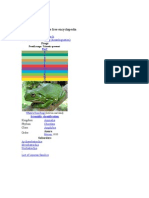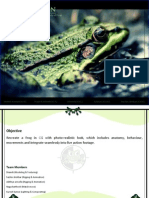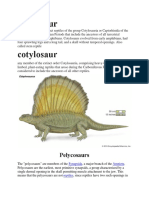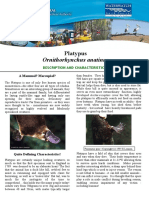0 ratings0% found this document useful (0 votes)
22 viewsFrog Anura: An-, Oura
Frog Anura: An-, Oura
Uploaded by
RasmusFrogs are a diverse group of tailless amphibians that first appeared over 265 million years ago. They are found all over the world, especially in tropical rainforests, with over 4,800 known species making up 85% of all amphibian species. Frogs have short bodies, protruding eyes, cleft tongues, limbs folded underneath, and lack tails. Their skin secretions range from distasteful to toxic and their colors vary from camouflage to bright warning patterns.
Copyright:
© All Rights Reserved
Available Formats
Download as DOCX, PDF, TXT or read online from Scribd
Frog Anura: An-, Oura
Frog Anura: An-, Oura
Uploaded by
Rasmus0 ratings0% found this document useful (0 votes)
22 views1 pageFrogs are a diverse group of tailless amphibians that first appeared over 265 million years ago. They are found all over the world, especially in tropical rainforests, with over 4,800 known species making up 85% of all amphibian species. Frogs have short bodies, protruding eyes, cleft tongues, limbs folded underneath, and lack tails. Their skin secretions range from distasteful to toxic and their colors vary from camouflage to bright warning patterns.
Original Description:
frogs
Original Title
Frogs
Copyright
© © All Rights Reserved
Available Formats
DOCX, PDF, TXT or read online from Scribd
Share this document
Did you find this document useful?
Is this content inappropriate?
Frogs are a diverse group of tailless amphibians that first appeared over 265 million years ago. They are found all over the world, especially in tropical rainforests, with over 4,800 known species making up 85% of all amphibian species. Frogs have short bodies, protruding eyes, cleft tongues, limbs folded underneath, and lack tails. Their skin secretions range from distasteful to toxic and their colors vary from camouflage to bright warning patterns.
Copyright:
© All Rights Reserved
Available Formats
Download as DOCX, PDF, TXT or read online from Scribd
Download as docx, pdf, or txt
0 ratings0% found this document useful (0 votes)
22 views1 pageFrog Anura: An-, Oura
Frog Anura: An-, Oura
Uploaded by
RasmusFrogs are a diverse group of tailless amphibians that first appeared over 265 million years ago. They are found all over the world, especially in tropical rainforests, with over 4,800 known species making up 85% of all amphibian species. Frogs have short bodies, protruding eyes, cleft tongues, limbs folded underneath, and lack tails. Their skin secretions range from distasteful to toxic and their colors vary from camouflage to bright warning patterns.
Copyright:
© All Rights Reserved
Available Formats
Download as DOCX, PDF, TXT or read online from Scribd
Download as docx, pdf, or txt
You are on page 1of 1
Frogs
A frog is any member of a diverse and largely carnivorous group of short-bodied,
tailless amphibianscomposing the order Anura (Ancient Greek an-, without + oura, tail).
The oldest fossil "proto-frog" appeared in the early Triassic of Madagascar, but molecular
clock dating suggests their origins may extend further back to the Permian, 265 million
years ago. Frogs are widely distributed, ranging from the tropics to subarctic regions, but
the greatest concentration of species diversity is in tropical rainforests. There are
approximately 4,800 recorded species, accounting for over 85% of extant amphibian
species. They are also one of the five most diverse vertebrate orders.
The body plan of an adult frog is generally characterized by a stout body,
protruding eyes, cleft tongue, limbs folded underneath, and the absence of a tail. Besides
living in fresh water and on dry land, the adults of some species are adapted for living
underground or in trees. The skin of the frog is glandular, with secretions ranging from
distasteful to toxic. Warty species of frog tend to be called toads but the distinction
between frogs and toads is based on informal naming conventions concentrating on the
warts rather than taxonomy or evolutionary history. Frogs' skins vary in colour from well-
camouflaged dappled brown, grey and green to vivid patterns of bright red or yellow and
black to advertise toxicity and warn off predators.
You might also like
- The Biology of ScorpionsDocument233 pagesThe Biology of ScorpionsAymer VásquezNo ratings yet
- Rogs Are A Diverse and LargelyDocument1 pageRogs Are A Diverse and LargelygordonskllllNo ratings yet
- FrogDocument2 pagesFrogmarikayathribala1987No ratings yet
- FrogDocument1 pageFrogLeticiaNo ratings yet
- FROGSDocument1 pageFROGSVAJRASWAMI PATHSALANo ratings yet
- FrogDocument2 pagesFrogLeo TeNo ratings yet
- Anura (: (Hide)Document4 pagesAnura (: (Hide)kbarn389No ratings yet
- FROGDocument1 pageFROGKidMonkey2299No ratings yet
- From Wikipedia, The Free Encyclopedia: Jump To:, For Other Uses, SeeDocument19 pagesFrom Wikipedia, The Free Encyclopedia: Jump To:, For Other Uses, Seenassamerg23No ratings yet
- Survey of AmphibiansDocument35 pagesSurvey of AmphibiansAeriel Venice VergaraNo ratings yet
- For Other Uses, See .: Frog (Disambiguation)Document6 pagesFor Other Uses, See .: Frog (Disambiguation)Mari Creon A. BaumgardnerNo ratings yet
- Frogs: From Wikipedia, The Free Encyclopedia This Article Is About The Group of Amphibians. For Other Uses, SeeDocument7 pagesFrogs: From Wikipedia, The Free Encyclopedia This Article Is About The Group of Amphibians. For Other Uses, SeemcmusbixNo ratings yet
- Frogs: From Wikipedia, The Free Encyclopedia This Article Is About The Group of Amphibians. For Other Uses, SeeDocument6 pagesFrogs: From Wikipedia, The Free Encyclopedia This Article Is About The Group of Amphibians. For Other Uses, SeemcmusbixNo ratings yet
- FrogDocument27 pagesFrogElvon LauNo ratings yet
- ReptilesDocument36 pagesReptilesArabelle Da FirstNo ratings yet
- ReptileDocument4 pagesReptileDratonius 101No ratings yet
- Endangered AnimalsDocument4 pagesEndangered AnimalsAhmed MostafaNo ratings yet
- Biology Project: AmphibiansDocument2 pagesBiology Project: AmphibiansMuhiddin ChandraNo ratings yet
- Amphibians 1Document11 pagesAmphibians 1mwanyemiwistonNo ratings yet
- Amphibians: The First Terrestrial VertebratesDocument35 pagesAmphibians: The First Terrestrial VertebratesAeriel Venice VergaraNo ratings yet
- Presentor: Alyanna D. de Leon Beed-1EDocument36 pagesPresentor: Alyanna D. de Leon Beed-1EAly D. De LeonNo ratings yet
- Phylum AnnelidaDocument6 pagesPhylum AnnelidaRechelle CabagingNo ratings yet
- Amphibians Are: Paedophryne Amauensis PrionosuchusDocument1 pageAmphibians Are: Paedophryne Amauensis PrionosuchusthearoyNo ratings yet
- AnimalDocument22 pagesAnimalJudin BellNo ratings yet
- Handouts VertebratesDocument5 pagesHandouts VertebratesDiane PamanNo ratings yet
- Amphibians 3Document6 pagesAmphibians 3Glenn GanganNo ratings yet
- ReptilesDocument19 pagesReptileszubariaiqbal61No ratings yet
- AnimalsDocument1 pageAnimalsMarco SánchezNo ratings yet
- History and Origin of ParrotsDocument38 pagesHistory and Origin of ParrotsShanmukha priyaNo ratings yet
- Animals: Cells Eukaryotic CellsDocument17 pagesAnimals: Cells Eukaryotic CellsFallianda YandaNo ratings yet
- Crețu Ovidiu Sava Silviu-Alexandru Petrescu Alex - Dumitru Cârjă CristianDocument15 pagesCrețu Ovidiu Sava Silviu-Alexandru Petrescu Alex - Dumitru Cârjă CristianBayneNo ratings yet
- Topic EcologyDocument5 pagesTopic EcologyJavier SmithNo ratings yet
- Reptiles: Snakes Lizards Crocodiles Turtles Tuatara VertebratesDocument10 pagesReptiles: Snakes Lizards Crocodiles Turtles Tuatara VertebratesJemarkTicmonMagpayoNo ratings yet
- AmphibiansDocument3 pagesAmphibiansAlejandroRozaNo ratings yet
- ArthropodsDocument8 pagesArthropodsLearn To EarnNo ratings yet
- Maryflor HigidaDocument11 pagesMaryflor HigidaMaryflor HigidaNo ratings yet
- Classifying InvertebratesDocument9 pagesClassifying InvertebratesKurt EmmañuelNo ratings yet
- THE Subdiscipline of Zoology: Group Members JugnoDocument32 pagesTHE Subdiscipline of Zoology: Group Members JugnoColeenNo ratings yet
- DecrioptionText About SnakeDocument4 pagesDecrioptionText About Snakerila nugrawatiNo ratings yet
- Frog DissertationDocument171 pagesFrog Dissertationcreatingcreator100% (1)
- Chapter 2 Snakes of Papua New GuineaDocument23 pagesChapter 2 Snakes of Papua New GuineaIrfan Haidar BasyirNo ratings yet
- Crab: 5 Types of Organisms Found in MonsoonDocument15 pagesCrab: 5 Types of Organisms Found in MonsoonAbhijeet SinghNo ratings yet
- Vertebrate ClassificationDocument5 pagesVertebrate Classificationaneesh sebastianNo ratings yet
- Reptiles: Prof. M. Srinivasan and Dr. S. BragadeeswaranDocument17 pagesReptiles: Prof. M. Srinivasan and Dr. S. BragadeeswaranRahul DattaNo ratings yet
- Neotropical Rainforest Mammals TalkDocument6 pagesNeotropical Rainforest Mammals TalkMisterJanNo ratings yet
- Arthropod: Animal Kingdom Lobsters Crabs Spiders Mites Insects Centipedes MillipedesDocument14 pagesArthropod: Animal Kingdom Lobsters Crabs Spiders Mites Insects Centipedes MillipedesAljofebes Ceniza ObedenciaNo ratings yet
- Chapter 18Document10 pagesChapter 18Aeriel Venice VergaraNo ratings yet
- UntitledDocument2 pagesUntitledKhristine RamosNo ratings yet
- MammalsDocument4 pagesMammalscristhianmadrid1415No ratings yet
- Turtles, Frogs, Snakes and Lizards | Children's Science & NatureFrom EverandTurtles, Frogs, Snakes and Lizards | Children's Science & NatureNo ratings yet
- Lab 8 Arthro PDFDocument9 pagesLab 8 Arthro PDFAtin FifaNo ratings yet
- Frogs vs. Toads: CaeciliansDocument2 pagesFrogs vs. Toads: CaeciliansZonny Zivins PresentsNo ratings yet
- Life-History Evolution in ReptilesDocument11 pagesLife-History Evolution in ReptilesjeraldNo ratings yet
- Class AmphibianDocument8 pagesClass AmphibianSulaiman OlanrewajuNo ratings yet
- Platypus PDFDocument2 pagesPlatypus PDFRaajeswaran BaskaranNo ratings yet
- Member of Group: 1. Akbar Hidayat 2. Akram Ramdhan 3. Bobby Gunawan 4. Muhammad Vijay 5. Rizki Febri K. 6. Tri BudiDocument5 pagesMember of Group: 1. Akbar Hidayat 2. Akram Ramdhan 3. Bobby Gunawan 4. Muhammad Vijay 5. Rizki Febri K. 6. Tri BudiakbarNo ratings yet
- Sishe Salsabila Luqyana Practicum ReportDocument27 pagesSishe Salsabila Luqyana Practicum ReportSalsabila LuqyanaNo ratings yet



























































